Research Article - (2023) Volume 14, Issue 9
Received: 08-Aug-2023, Manuscript No. AASRFC-23-17890; Editor assigned: 11-Aug-2023, Pre QC No. AASRFC-23-17890 (PQ); Reviewed: 25-Aug-2023, QC No. AASRFC-23-17890; Revised: 28-Sep-2023, Manuscript No. AASRFC-23-17890 (R); Published: 26-Oct-2023, DOI: 10.36648/0976-8610-14.5.43
When we examine some of the hypotheses that have contributed to the acceptance of inflationary ideas, we can more clearly see the metaphysical nature of some of the current cosmological conjecture. In particular, there is one hypothesis that has now gained widespread acceptance: The hypothesis that the universe may have originated from nothing.
This is something that follows from a principle known as the law of conservation of energy, which states that if energy is not added to a system or allowed to escape, it must stay in the same state. Energy may change forms, but the overall amount does not change. However, as the earth approaches the sun, it will move at an ever-increasing speed and receive steadily more energy for motion. However, because the system's total energy remains constant, the gravitational energy must subsequently turn increasingly negative. It is necessary to consider that the earth's velocity has been slowed down, possibly by powerful braking missiles or another means and that it has been allowed to settle into an orbit that is identical to the one it currently occupies. In this scenario, the majority of the kinetic energy would have been wasted. But gravitational energy continues to make a considerable contribution.
Because we lack the resources to conduct an experiment to test this hypothesis, we cannot test whether the universe actually began in this manner by traveling back in time. Similarly, we cannot test whether this can also occur in other universes. Finally, we do not know whether the universe's content of matter and energy is truly zero. When two numbers are this large and appear to be equal, it may be difficult to determine with certainty whether or not they are equal.
In this manuscript, I will put forward some examples of cases in which the amount of energy had a negative value, it is a theoretical guesswork which has gone so far that the experiment has lagged far behind it and I will also mention further comments on the nature of these theoretical attempts, although it is better for our moment to continue the topic of our discussion and I would like to ask the following question: Are the theories of the inflationary universe a matter of physics or metaphysics?
Hypothesis; Manuscript; Gravitational energy; Physics
Energy from Nothingness
The metaphysical character of some of the conjecture currently taking place in the ield of cosmology, is what can be seen more dramatically, once we take an examination of some of the conjectures that have led to the approval of in lationary ideas and there is in particular a supposition that has now become very common and that is the supposition that says that the universe may have come into existence from nothingness [1].
And this idea was founded on the basis that if the universe had undergone in lationary expansion at some time in its history, then it was possible that it was originally devoid of matter and energy or very close to being devoid of them and it is possible that the universe began as an expanding bubble of space-time is very small in size and all the matter and energy that exists now could have been created during the brief period of bulging expansion. We can even say that when the universe went through this phase, matter and energy rushed to ill the rapidly expanding void (Figure 1).
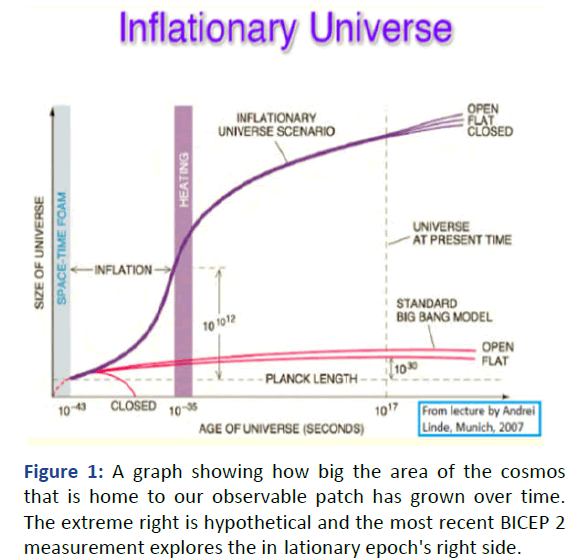
Figure 1: A graph showing how big the area of the cosmos that is home to our observable patch has grown over time. The extreme right is hypothetical and the most recent BICEP 2 measurement explores the in lationary epoch's right side.
And this is possible, because while the matter content of the universe is positive, gravitational energy has a negative contribution and since Einstein's equation E=mc2 includes that matter and energy are nothing but two different aspects of the same thing (even if we wanted to put a place. The two terms are one term, if we wish, we will call it matter-energy) and therefore it should be possible to create a huge amount of matter and energy out of nothingness, provided that the positive and negative contributions are such that they balance each other and in particular there is no reason why it cannot be created positive matter and negative gravitational energy (Figure 2) [2].
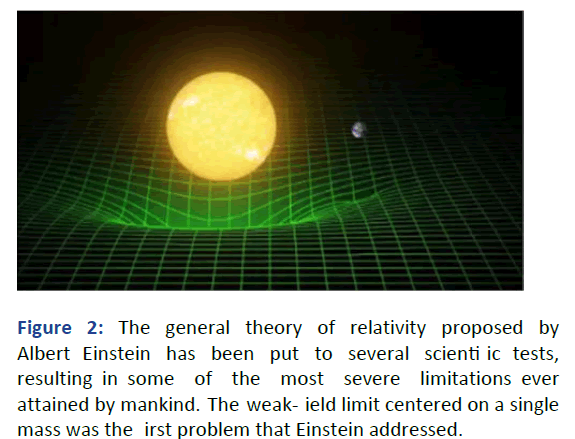
Figure 2: The general theory of relativity proposed by Albert Einstein has been put to several scienti ic tests, resulting in some of the most severe limitations ever attained by mankind. The weak- ield limit centered on a single mass was the irst problem that Einstein addressed.
In order to see why the total amount energy of the universe should be negative, it is necessary to note irst that most of this energy exists in the form of gravitational energy. And the energy in the gravitational ields that hold together stars, planets, galaxies and clusters of galaxies is much greater than all forms of energy combined. Every particle attracts another and on the other hand, the strong force, as an example, only acts between protons and neutrons which are practically in contact and it is true that the electromagnetic force also has a long range, as long as matter is electrically neutral and why while magnetic ields in the universe tend to be relatively weak, this force does not act over great distances as the force of gravity does [3].
So, according to what is in this cosmic plan of the universe, gravity has a much greater importance than light, heat and radioactivity. The universe has much more gravitational energy than there is in nuclear energy. In addition, this gravitational energy is negative and it is a very large negative amount. So that all the positive contributions of other types of energy are insigni icant and the idea of negative energy may seem a bit strange at irst, but this concept will seem very reasonable once we ask about the conditions in which gravitational energy becomes zero and the answer to this question is clear and it is when the gravitational bodies are far away from each other at a very great distance so that they do not exert any attraction and as an example, the gravitational energy in the system that consists of the earth and the sun becomes zero if the earth was moved in some way to a very far distance from the sun so that it does not feel a ter any pull caused by gravity, here I only take into account the energy associated with the pull of the earth on the sun and not the gravitational energy contained in the sun or the earth themselves [4].
It is noticed that if we are to somehow move the earth from its present orbit into interstellar space, it will be necessary to expend a great deal of positive energy and if we have to expend energy to get the earth to a position where its energy is zero, it follows from this that the energy that it has now must be negative, as the matter is as simple as adding a positive number to a negative number, so if we add +5 to an unknown amount, and we end up with zero, then what we have must be -5 (Figure 3).
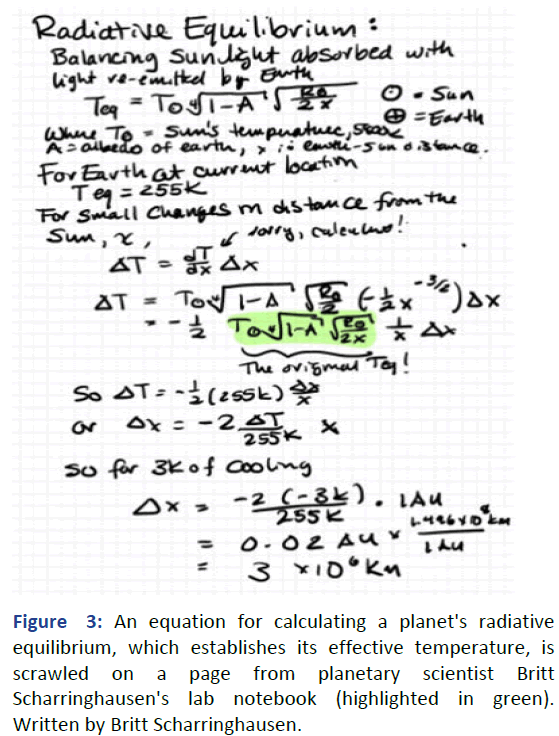
Figure 3: An equation for calculating a planet's radiative equilibrium, which establishes its effective temperature, is scrawled on a page from planetary scientist Britt Scharringhausen's lab notebook (highlighted in green). Written by Britt Scharringhausen.
This same argument can be invoked in reverse. If we now imagine that the earth was at first very far away in space and then was allowed to fall again to the sun, we will reach the same conclusion, even if we assume that there is no force that exerts its effect on the earth. Other than gravity and that except for some small initial impulse, the total energy in the system consisting of the earth and the sun must always remain zero [5].
And this is something that follows from a law that physicists call the law of conservation of energy, because if we do not shed energy into a system and we do not allow energy to escape, then the energy must remain the same as it is and the energy may change from one form to another, but the total amount does not change. However, when the earth falls to the sun, the earth will move at a speed that is increasing more and more and it will gain steadily increasing energy for movement, but since the total energy in the system remains the same, the gravitational energy must then become negative more and more. Finally, we must imagine that the earth's motion has been slowed down, perhaps by massive braking missiles or something of that sort and that it has been allowed to settle into an orbit exactly the same as the one it now occupies, in which case most of the kinetic energy would have been lost. But the signi icant contribution of gravitational energy remains (Figure 4).
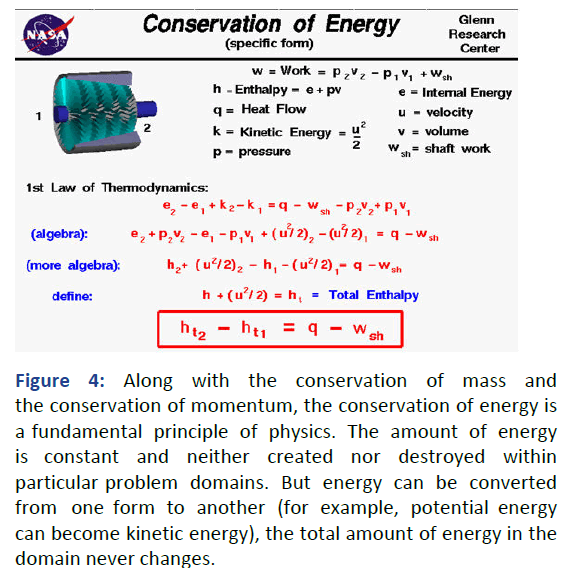
Figure 4: Along with the conservation of mass and the conservation of momentum, the conservation of energy is a fundamental principle of physics. The amount of energy is constant and neither created nor destroyed within particular problem domains. But energy can be converted from one form to another (for example, potential energy can become kinetic energy), the total amount of energy in the domain never changes.
And now it is agreed that we can calculate the contribution of each of the matter and the gravitational energy to the balance of matter and energy in the universe and finally prove that the contribution of matter is a very large positive number and that the contribution of gravity is a very large negative value, are the two quantities balanced exactly? No one really knows that, but it's very possible that they are. And the American physicist Edward Tryon proposed in 1973 that the universe may have been originally a quantum fluctuation that arose from nothingness and Tryon assumed this, which is a completely speculative assumption, based on the observation that, according to Heisenberg's uncertainty principle, the smaller the amount of energy needed to create a particle, the time in which the particle is allowed to exist has increased and specifically if there is something like a particle with energy equal to zero, it will be allowed to remain for an infinite time in its range and it is clear that there are no such particles, as there are particles such as the photon with mass value equals zero, but the energy that the photons have is not zero and the truth is that would be a contradiction, because light is a form of energy and light consists of photons and if they existed, they would be entities like ghosts that can never be interacting with any kind of matter, on the other hand, the idea of a universe with zero energy is perfectly reasonable [6].
This idea becomes especially plausible when it is tested in theories of the inflationary universe. A universe that may have originally contained only a very few particles could have started as a small quantum fluctuation of some kind. In fact, there are other forms of this. The assumption is that the number of particles is originally two: A particle and its antiparticle and if the fluctuation remains long enough for an inflationary expansion to begin, then the continuity of the universe is confirmed and as space expands, matter and energy can flow into the universe and fill the expanding space quickly and finally the expansion stops and the universe gradually evolves into the universe we now observe (Figure 5) [7,8].
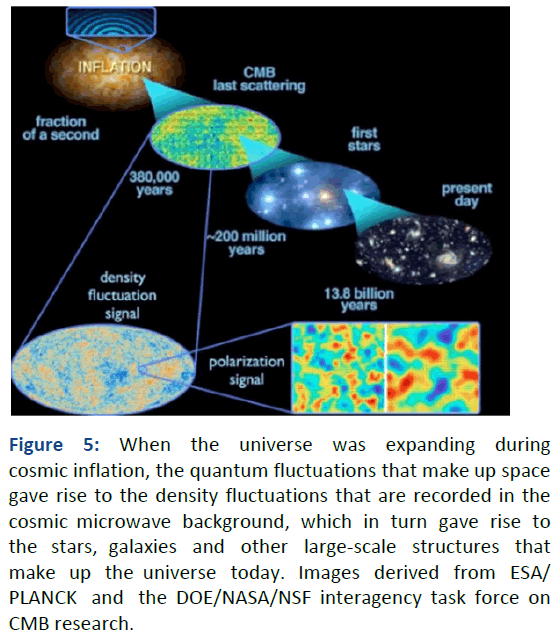
Figure 5: When the universe was expanding during cosmic inflation, the quantum fluctuations that make up space gave rise to the density fluctuations that are recorded in the cosmic microwave background, which in turn gave rise to the stars, galaxies and other large-scale structures that make up the universe today. Images derived from ESA/ PLANCK and the DOE/NASA/NSF interagency task force on CMB research.
This scenario seems very plausible and attractive in many ways, as it provides a possible answer to the question: Where did the universe come from? In addition, it is a very economical theory, because the assumptions on which it is based are simple and few and on the other hand it is not really clear whether this kind of speculation should or should not be called a science or whether it has a connection with metaphysical philosophy and theories in science are supposed to be tested, so what experiment could researchers possibly conduct to test this theory (Figure 6).
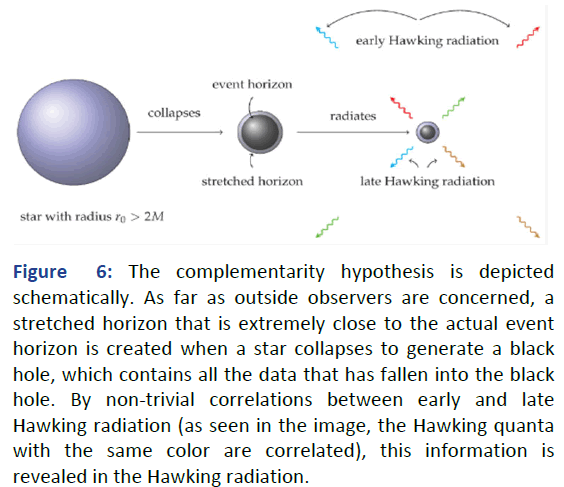
Figure 6: The complementarity hypothesis is depicted schematically. As far as outside observers are concerned, a stretched horizon that is extremely close to the actual event horizon is created when a star collapses to generate a black hole, which contains all the data that has fallen into the black hole. By non-trivial correlations between early and late Hawking radiation (as seen in the image, the Hawking quanta with the same color are correlated), this information is revealed in the Hawking radiation.
Obviously we can't do an experiment that requires going back in time to see if the universe really began that way, just as we cannot see if this can occur to other universes because we do not have any materials to do an experiment to prove this hypothesis and finally we do not know whether the content of the universe of matter and energy is really zero and when we have two numbers that are very large and apparently equal, it may be impossible to know exactly whether or not one cancels the other (Figure 7) [9,10].
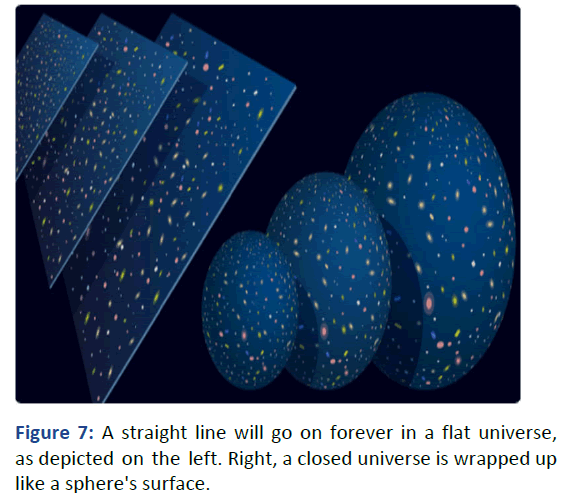
Figure 7: A straight line will go on forever in a flat universe, as depicted on the left. Right, a closed universe is wrapped up like a sphere's surface.
Like if we have one trillion and one trillion and ten, we will never know if they are equal or unequal if we can only measure them with an accuracy of one part in a billion.
This is not an unfortunate situation and the truth is that I regard it as a healthy one. After all, it was the desire to speculate about the nature of the universe that made the thought of certain earlier ages great. Upon their reading and today, when we have at our disposal much more knowledge than they had, we should not allow ourselves to be less bold than they [11,12].
On the other hand, if we allow metaphysics to disguise itself as science, nothing will result but confusion and when scientists speculate on ideas that cannot be tested, even ideas that may not be subjected to test, they should be prepared to admit that this is the activity in which they are engaged. Not quite a scientific activity, as some want us to believe [13].
The difference between science and philosophy is supposed to be that scientific ideas are empirically testable, while philosophical ideas are not, but this principle is now being violated with increasing frequency and it is interesting to note that during the early part of the twentieth century, philosophers were toiling hard to make their knowledge system more rigorous, but now in the twenty-first century, the physicists that philosophers were trying so hard to emulate, became, scientists, who introduce untestable ideas into their knowledge system and this case became more and more frequent.
[Crossref] [Google Scholar] [PubMed]
[Crossref] [Google Scholar] [PubMed]
[Crossref] [Google Scholar] [PubMed]
[Crossref] [Google Scholar] [PubMed]
Citation: El-Sayed ABA (2023) Can the Amount of Energy have A Negative Value? Adv Appl Sci Res. 14:43.
Copyright: © 2023 El-Sayed ABA. This is an open-access article distributed under the terms of the Creative Commons Attribution License, which permits unrestricted use, distribution, and reproduction in any medium, provided the original author and source are credited.